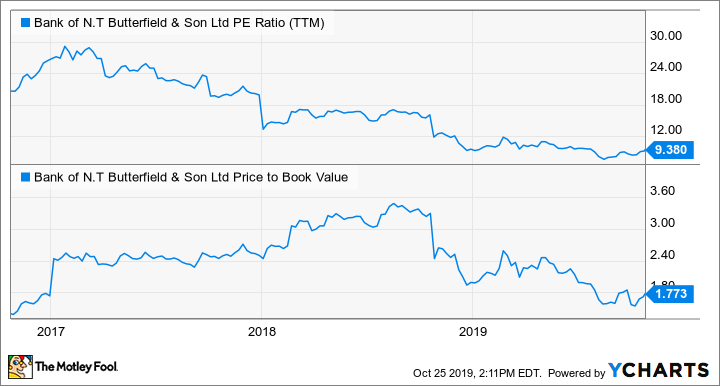Motley Fool says: The ultrarich have $13 Billion at this offshore bank – Here’s why you should buy
Bank of N.T. Butterfield may not be a household name for most people, but it’s an institution for offshore banking. It’s also cheap and pays a very high dividend yield.
By Jason Hall (TMFVelvetHammer) From Motley Fool
The Bank of N.T. Butterfield & Son Limited (NYSE:NTB) doesn’t exactly roll off the tongue. Chances are, it’s also not a bank that most people have ever heard of — and for good reason since it doesn’t do business with Main Street. Butterfield has its core operations in Bermuda, the Cayman Islands, and the Channel Islands Jersey and Guernsey.
It’s also been in business for more than 160 years, and with $12.6 billion in deposits, it’s well-known among the well-to-do and growing its presence. It’s also less than five years into its life as a public company and still relatively below the radar of most investors.


IMAGE SOURCE: GETTY IMAGES.
But when you look beyond the bank’s relative obscurity with retail investors, you’ll find a high-quality business that’s well run, very profitable, and undervalued. It also pays one of the highest dividend yields you’ll find from a bank. Keep reading to learn more about this easy-to-miss offshore bank that should probably be in your portfolio.
Butterfield is exceptionally profitable
Butterfield’s status as an offshore bank might make some investors look at it askance. After all, most people associate banking in the Cayman Islands or Bermuda with tax avoidance, at best, and illicit activities, at worst. However, the reality is more straightforward. More individuals and businesses now own assets or conduct business across many borders, and having established banking relationships in these localities simply makes things easier.
Butterfield has proven exceptionally good at conducting this business in a very profitable manner. Since going public in late 2017, it has delivered exceptional returns and has grown earnings sharply:


NTB RETURN ON EQUITY (TTM) DATA BY YCHARTS.
For context, most bank stock investors will tell you the benchmark targets are 10% and 1% on return on equity (ROE) and return on assets (ROA), and Butterfield simply blows past those metrics. Combine the strong returns it earns with solid operations, and Butterfield generates very strong earnings.
It shares those profits with investors, too
Soon after going public less than four years ago, Butterfield implemented a dividend. It has increased the payout three times, raising it by 340%. Over the same period, earnings per share have increased 153%. Going forward, investors shouldn’t expect such aggressive dividend growth; the reality is, it’s not sustainable to continue growing the payout more than twice the rate of earnings growth.
However, the dividend is still very secure, with a payout ratio — the percentage of earnings paid in dividends — below 50%:


NTB DIVIDEND DATA BY YCHARTS.
At recent prices, Butterfield’s dividend yield is 5.4%, one of the biggest yields you’ll find from any bank.
Butterfield is cheap
At recent prices, Butterfield shares trade for less than 9.4 times trailing earnings. Not only is that on the lower end of the multiple investors have paid for it since going public, but a single-digit earnings valuation for this bank is just plain cheap.
Moving over to book value — how much its shares trade for compared to the carrying value of its assets — it’s also on the lower end of the range it has traded for. However, at nearly 1.8 times book value, it doesn’t look as cheap as its earnings multiple.


NTB PE RATIO (TTM) DATA BY YCHARTS.
Generally speaking, 1.5 times book value is often considered a good benchmark for banks. But here’s the rub: You can’t really look at Butterfield’s book value through the same lens as most other banks. Let’s go back to its ROE and ROA to help explain why, using JPMorgan Chase (NYSE:JPM):


NTB RETURN ON EQUITY (TTM) DATA BY YCHARTS.
JPMorgan is one of the best-run, best-regarded banks in the world. And as the chart above shows, it also outperforms the returns benchmarks of 10% and 1%. However, Butterfield’s returns leave even one of the world’s best-run banks in the dust.
That’s not to say that Butterfield is the better bank. It’s a difference in their core businesses. Simply put, Butterfield should generate higher returns, and those higher returns should also be reflected in its valuation. Today, that valuation doesn’t reflect the returns or the earnings power of Butterfield’s assets and operations.
Put it all together, and investors would do well to add Butterfield to their portfolios. Between its strong business, cheap valuation, and high yield, it looks like a great way to grow your wealth with a bank that caters to the world’s ultra-wealthy.
10 stocks we like better than Bank of N.T. Butterfield & Son
When investing geniuses David and Tom Gardner have a stock tip, it can pay to listen. After all, the newsletter they have run for over a decade, Motley Fool Stock Advisor, has quadrupled the market.*
David and Tom just revealed what they believe are the ten best stocks for investors to buy right now… and Bank of N.T. Butterfield & Son wasn’t one of them! That’s right — they think these 10 stocks are even better buys.
*Stock Advisor returns as of June 1, 2019
Jason Hall owns shares of Bank of N.T. Butterfield & Son. The Motley Fool owns shares of and recommends Bank of N.T. Butterfield & Son. The Motley Fool has a disclosure policy.
For more on this story go to: https://www.fool.com/investing/2019/10/26/the-ultrarich-have-13-billion-at-this-offshore-ban.aspx





